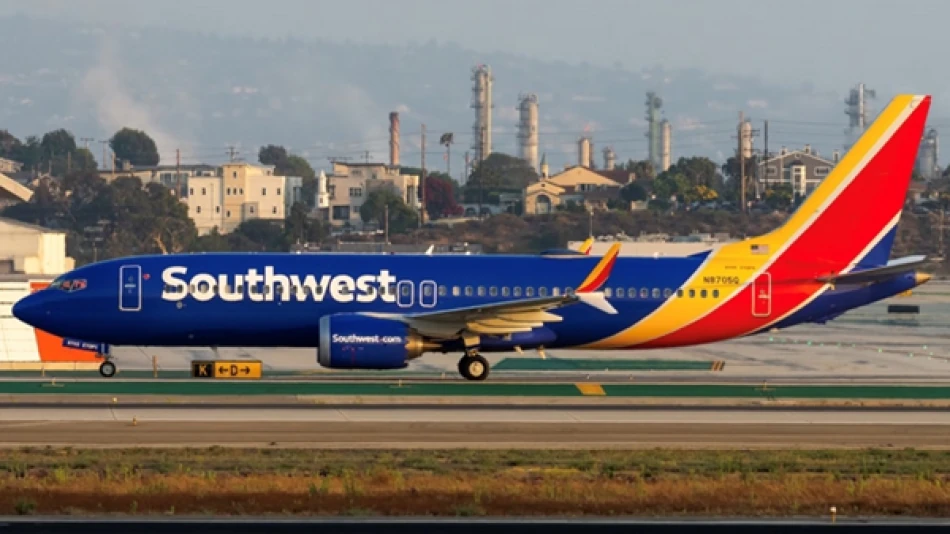
Daring Aerial Maneuver: US Plane Averts Near-Collision in the Skies
Southwest Airlines Flight Plunges to Avoid Mid-Air Collision, Exposing Critical Gaps in US Airspace Management
A Southwest Airlines flight was forced into an emergency descent Friday after its collision avoidance system activated to prevent a catastrophic mid-air crash with another aircraft. The dramatic maneuver sent passengers and crew flying into the cabin ceiling, injuring two flight attendants and highlighting serious concerns about airspace coordination over one of America's busiest aviation corridors.
When Split-Second Decisions Prevent Disaster
Southwest Flight 1496, carrying passengers from Burbank to Las Vegas, experienced what aviation experts describe as one of the most dangerous scenarios in commercial flying. The aircraft's Traffic Collision Avoidance System (TCAS) detected an imminent threat and commanded an immediate altitude change, dropping the Boeing 737 "dozens of meters" in seconds.
Comedian Jimmy Dore, who was aboard the flight, described the terrifying experience on social media: "Several of us were thrown from our seats and our heads hit the ceiling." The pilot later explained that another aircraft was heading directly toward them, forcing the emergency maneuver.
The Physics of Aviation Emergency Maneuvers
The violent nature of the incident underscores the extreme forces involved when large commercial aircraft make sudden altitude changes. Modern jetliners typically descend at controlled rates of 1,000-2,000 feet per minute during normal operations. Emergency TCAS responses can command descent rates exceeding 2,500 feet per minute, creating G-forces that can launch unrestrained passengers and crew members toward the cabin ceiling.
Military Aircraft Raises Questions About Airspace Coordination
Flight tracking data from FlightAware revealed a crucial detail: a Hawker Hunter MK 58 fighter jet was operating in the same airspace near Burbank at the time of the incident. This raises immediate questions about coordination between civilian air traffic control and military flight operations.
The Hawker Hunter, a vintage British-designed fighter jet now used primarily for airshows and private military contracting, represents the growing complexity of modern airspace management. Unlike the 1950s when such aircraft were primarily military assets, today's skies must accommodate commercial airlines, private jets, military operations, and an increasing number of civilian-owned warbirds.
Burbank: A Challenging Aviation Environment
Hollywood Burbank Airport sits in one of the nation's most congested airspace regions, surrounded by Los Angeles International Airport, multiple military installations, and heavy private aviation traffic. The airport's proximity to entertainment industry operations also means frequent helicopter traffic and specialized aircraft movements that can complicate air traffic control coordination.
TCAS: The Last Line of Defense
The Traffic Collision Avoidance System that likely prevented a catastrophic collision Friday represents decades of aviation safety evolution. Mandated for commercial aircraft following several deadly mid-air collisions in the 1970s and 1980s, TCAS operates independently of ground-based air traffic control systems.
When two aircraft equipped with transponders approach each other at dangerous speeds and altitudes, TCAS automatically coordinates between both aircraft—one receives a "climb" command while the other gets "descend." Pilots are trained to follow these commands immediately, even if they conflict with air traffic control instructions.
Why TCAS Activations Signal Systemic Problems
While TCAS prevented disaster in this case, aviation safety experts view such incidents as indicators of broader air traffic management failures. Modern airspace is designed with multiple layers of separation—procedural, radar-based, and finally TCAS as the last resort. When the system reaches the TCAS activation stage, it means earlier safety barriers have failed.
Implications for Aviation Safety and Regulation
The Federal Aviation Administration's investigation into Friday's incident comes amid growing concerns about airspace capacity and safety in the United States. The agency faces mounting pressure to modernize air traffic control systems while managing increasing flight volumes and diverse aircraft types.
For Southwest Airlines, the incident represents both a operational success—the crew followed proper procedures and prevented casualties—and a potential liability concern. The airline confirmed that two flight attendants required medical treatment, though all passengers remained uninjured.
The Broader Context of Aviation Near-Misses
This incident joins a troubling pattern of close calls in American airspace. The FAA has documented increasing numbers of "runway incursions" and airspace conflicts as flight operations return to pre-pandemic levels. The integration of military aircraft, vintage warbirds, and growing drone operations adds complexity that existing air traffic systems struggle to manage effectively.
Friday's near-collision over Burbank serves as a stark reminder that despite aviation's excellent safety record, the margin for error continues to shrink as America's skies become increasingly crowded. The FAA's investigation findings could influence future policies on military-civilian airspace coordination and the certification requirements for vintage military aircraft operating in commercial flight paths.
 Layla Al Mansoori
Layla Al Mansoori







